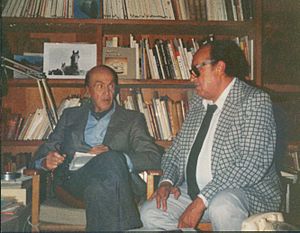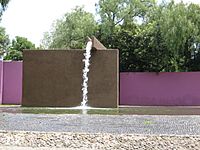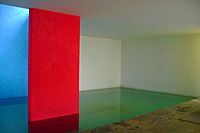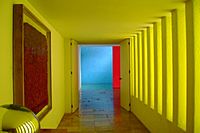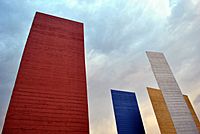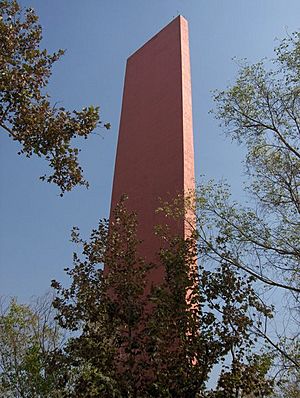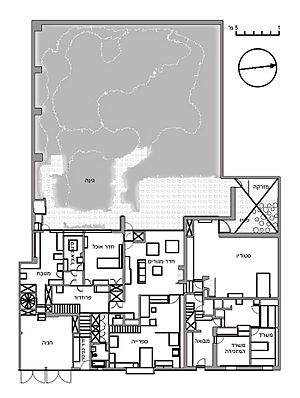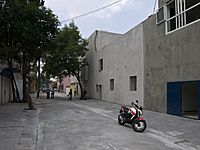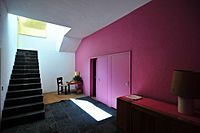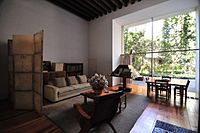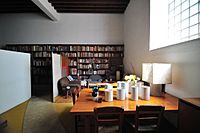Luis Barragán facts for kids
Quick facts for kids
Luis Barragán
|
|
|---|---|
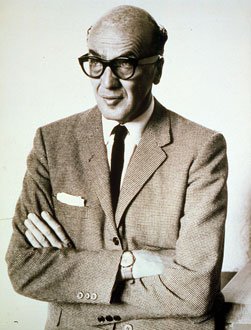
Barragán in 1960s.
|
|
| Born | March 9, 1902 |
| Died | November 22, 1988 (aged 86) Mexico City, Mexico
|
| Nationality | Mexican |
| Occupation | Architect |
| Awards | Pritzker Prize |
| Buildings | Torres de Satélite, Casa Gilardi, Barragán House, Jardines de Pedregal Subdivision |
Luis Ramiro Barragán Morfín (born March 9, 1902 – died November 22, 1988) was a famous Mexican architect and engineer. His unique work has inspired many modern architects. Students and teachers of architecture from all over the world often visit his buildings.
Barragán won the Pritzker Prize in 1980. This is the highest award an architect can receive. His own home, the Luis Barragán House and Studio, became a World Heritage Site by UNESCO in 2004.
Contents
Early life and travels
Barragán was born in Guadalajara in Jalisco, Mexico. He studied engineering and graduated in 1923. After finishing school, he traveled through Spain and France.
In France, he learned about the ideas of Ferdinand Bac. Bac was a writer, designer, and artist who greatly influenced Barragán. Later, in 1931, Barragán traveled to France again. He met other artists and architects, including Le Corbusier. Barragán started his architecture career in Guadalajara in 1927. He moved his practice to Mexico City in 1936.
Amazing architectural projects
In Guadalajara, Barragán designed more than a dozen private homes. These were some of his first projects. One of his early buildings, Casa Cristo, has been restored. It is now home to the state's Architects' Guild.
Famous designs and buildings
In 1945, Barragán began planning a large neighborhood called Jardines del Pedregal in Mexico City. In 1947, he built his own house and studio in Tacubaya. He also helped rebuild a convent in Tlalpan, Mexico City, in 1955.
A very famous project from 1957 is the Torres de Satélite. These are tall, colorful towers that stand as an urban sculpture. He worked with sculptor Mathias Goeritz on this project. He also designed the Las Arboledas neighborhood nearby. In 1967, he created the San Cristóbal Estates, a beautiful horse-riding development.
-
Torres de Satélite (with Mathias Goeritz)
Barragán's unique style
Barragán was influenced by a style called Modernism. This style uses clean lines and simple shapes. However, Barragán believed that a house should not just be "a machine for living."
He wanted to create "emotional architecture." He felt that buildings should make people feel calm and peaceful. Barragán used natural materials like stone and wood. He was also a master at using light, both natural sunlight and hidden artificial lights. This gave his buildings a very special and beautiful feeling.
Awards and recognition
For many years, Barragán's work was not widely known. But in 1975, the Museum of Modern Art in New York City held a special show about his work. This brought him a lot of attention.
In 1980, he won the Pritzker Architecture Prize, a huge honor. His house and studio in Mexico City, built in 1948, was named a UNESCO World Heritage Site in 2004. This means it is a place of special importance to the world.
His lasting influence
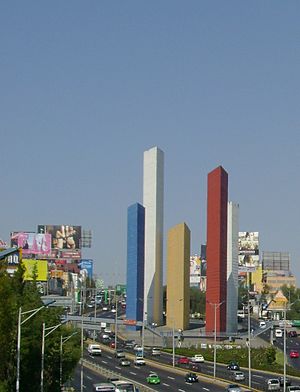
Luis Barragán's work is often linked to minimalist architecture. Minimalist buildings use very few elements and simple forms. Even though Barragán loved using bright colors, his ideas about shapes and spaces are still important to minimalist architects.
He also gave advice to other famous architects. For example, he helped Louis Kahn design the outdoor space at the Salk Institute for Biological Studies in California. Barragán suggested an open plaza with a water feature. This design is now a very famous part of the building. Barragán was known for his amazing ability to imagine outdoor spaces. He could see how they connected to the inside of buildings and to nature.
Many modern Mexican architects, like Ricardo Legorreta, have been inspired by Barragán. Legorreta's Hotel Camino Real in Mexico City shows Barragán's ideas about color and modern design.
His legacy
Barragán passed away in Mexico City when he was 86 years old. He left his legacy to three people. His friend, Ignacio Díaz Morales, received his library. His childhood friend, Óscar Ignacio González, received his personal items. His business partner, Raúl Ferrera, received his archives and the rights to his work.
The Fundación de Arquitectura Tapatía was created to manage Barragán's house. The house is now a museum. It helps people learn about Barragán and visit his other buildings in Mexico. In 2004, UNESCO added the Casa Luis Barragán to its World Heritage List.
After Raúl Ferrera died, his archives were sold to the Vitra Design Museum in Switzerland. The Barragan Foundation in Switzerland now manages these archives. Their goal is to share knowledge about Luis Barragán's cultural legacy. They do this by studying his archives, creating publications, and helping other researchers.
Important works
All of Barragán's finished projects are located in Mexico.
- Las Arboledas / North of Mexico City (1955–1961)
- House for the architect / Barragán House, Mexico City (1947–48)
- Jardines del Pedregal Subdivision, Mexico City (1945–53)
- Tlalpan Chapel, Tlalpan, Mexico City (1954–60)
- Gálvez House, Mexico City (1955)
- Jardines del Bosque Subdivision, Guadalajara (1955–58)
- Torres de Satélite, Mexico City (1957–58), with Mathias Goeritz
- Cuadra San Cristóbal, Los Clubes, Mexico City (1966–68)
- Gilardi House, Mexico City (1975–77)
- Cuernavaca Racquet Club, Cuernavaca, Morelos, Mexico (1976-1980)
Luis Barragán House and Studio
Luis Barragán's own house and studio are in Mexico City. This building is now a museum. You can visit it by making an appointment. Barragán lived in this house, built in 1948, for his entire life. It shows his favorite architectural style.
Today, the house is owned by Jalisco and the Arquitectura Tapatía Luis Barragán Foundation. In 2004, UNESCO named it a World Heritage Site.
See also
 In Spanish: Luis Barragán para niños
In Spanish: Luis Barragán para niños


